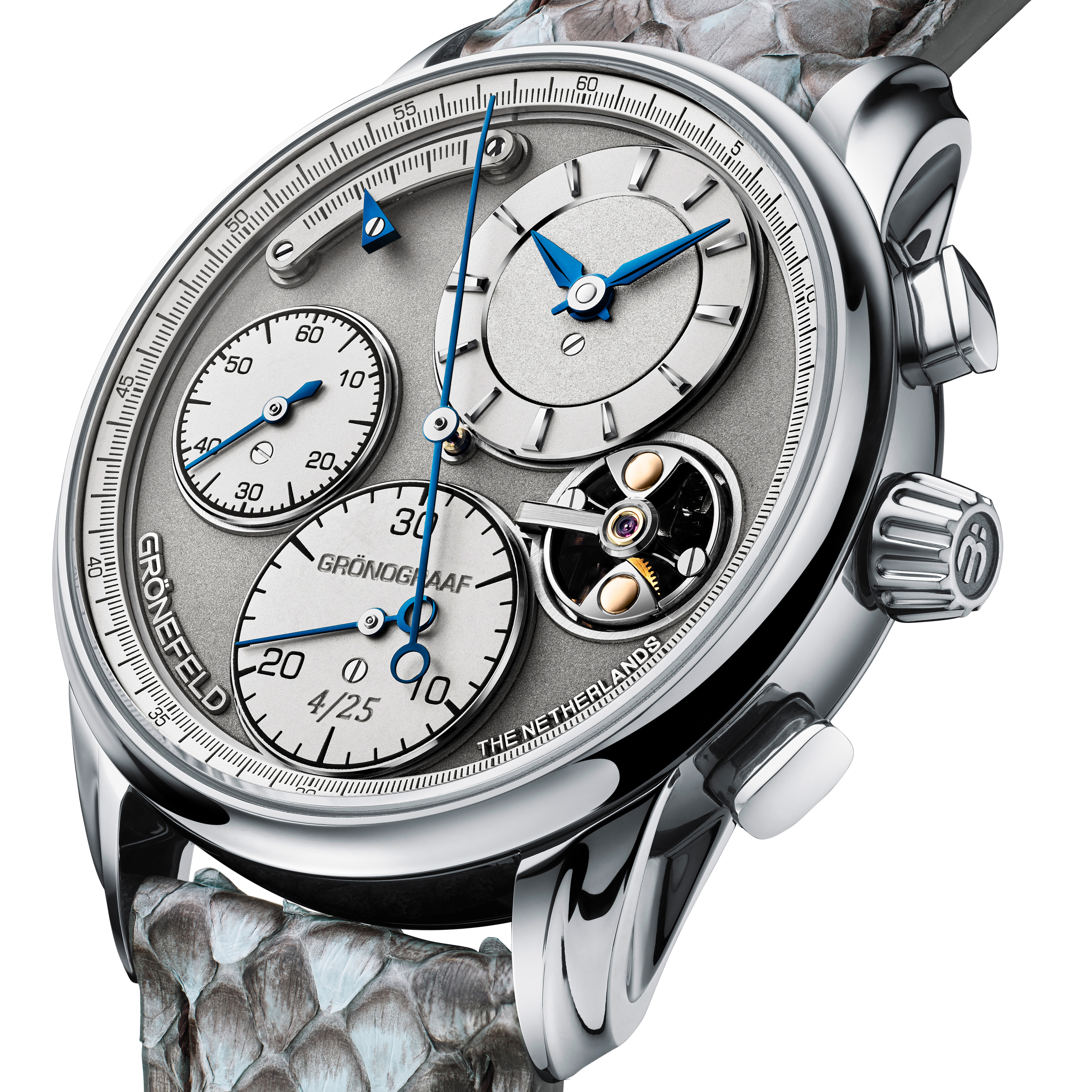
1941 Grönograaf Tantalum
Power reserve: 53 h, 21600 vph
Soft reset to zero. Slow return of hands
Grönefeld 1941 Grönograaf
Bart and Tim Grönefeld, aka ‘The Horological Brothers’, have produced a number of different watches endowed with a variety of complications, however, the 1941 Grönograaf is their first chronograph. Consistent with the Grönefeld ethos, this new model incorporates several ingenious details.
The 1941 Grönograaf features a classical configuration with its column-wheel and lateral coupling, a combination synonymous with high-end watchmaking. Its movement, the calibre G-04, is a symphony of 408 parts which not only encompasses quality materials but also upholds Grönefeld’s ‘no-compromise’ approach to finishing.
Mindful that chronograph movements are often subject to harsh forces that can sometimes scar hammers and bend hands, The Horological Brothers conceived a less aggressive system, a ‘soft reset’ mechanism. This employs a centrifugal governor, positioned at 4 o’clock, a mechanism typically seen on minute repeaters. The governor includes two solid gold weights. When the reset to zero pusher is pressed, the governor bursts into life, delivering a wonderful, animated performance.
A further dose of mechanical theatre comes with the motion of the counter hands when the reset to zero pusher is actuated. Depending on the position of the heart-shaped cams linked to the counter hands, the relevant minutes and seconds hands rotate clockwise or counter clockwise.
The ruby jewelled hammers also lessen any potentially harsh forces when returning to zero. Meanwhile, the keyless works features a conical winding pinion and crown-wheel, delivering a smooth winding action. Furthermore, the Philips terminal overcoil enhances isochronism, effectively causing the balance spring to breathe more concentrically.
The mainplate is embellished with spotting, while the bridges are formed of stainless steel, polished by hand. Moreover, the bridges have micro-blasted centres, circular graining on the top and feature various engravings in relief. The heart-shaped cams, the elongated chronograph bridge, the gold chatons and the screw-heads are all embellished with black polishing, executed in the traditional way using diamond paste on a tin plate. Every detail is intended to augment refinement.
In 2016, Bart and Tim released the 1941 Remontoire, honouring their father, Sjef, by referencing the year of his birth. The model’s 39.5mm case was subsequently used for the Principia automatic and the Decennium Tourbillon. With the advent of the 1941 Grönograaf, the sinuously shaped 1941 case returns, albeit it is a smidgen larger, this time measuring 40mm in diameter. The inaugural version of the 1941 Grönograaf, a limited edition of 25 pieces, is housed in a tantalum case. Bart and Tim selected this material because it is hard, corrosion resistant, bioinert and exhibits a lustrous, blue-grey gleam.
The hours and minutes are shown on an off-centre dial, indicated using Lancette hands and trapezoidal indexes. The hands are flame-blued steel, upholding watchmaking tradition, while the centres are mirror polished.
A 30-minute counter, located at the base of the dial, features a Breguet-style hand and is equipped with an instantaneous jumping minutes, conferring ease of read-off. A subsidiary seconds display resides at 9 o’clock, while a power reserve indicator, positioned above, is equipped with a pointer, seemingly floating adjacent a track, conveying the status of the mainspring. The Breguet-style central chronograph seconds hand converses with a crisply-marked track positioned on the rehaut, proclaiming the elapsed seconds in an intelligible format.
The 1941 Grönograaf is the distillation of three generations of watchmaking know-how, the professional journeys of both Horological Brothers and the manifestation of their extraordinary passion for horology.



